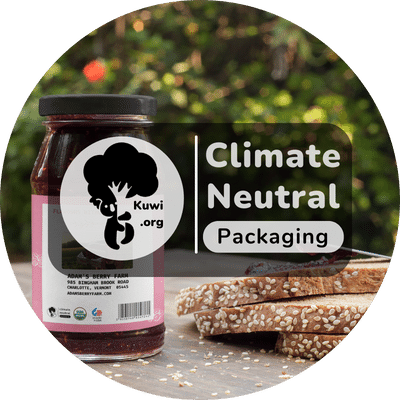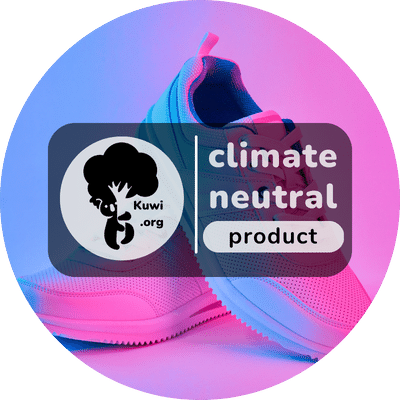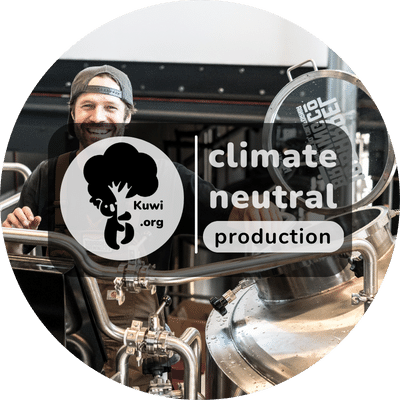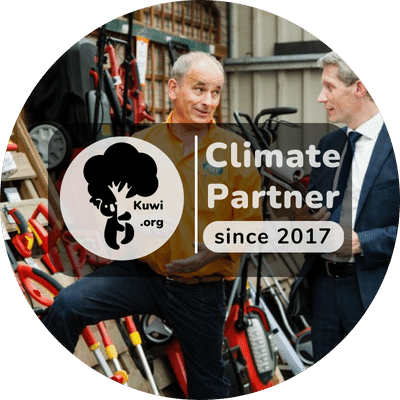The footprint of packaging material
You increasingly see boxes and other packaging with the ‘climate-neutral packaging’ label from Kuwi.org. Or you come across an inspiring story about CO₂ reduction projects on your package with a reference to kuwi.org. What this exactly entails, you can read here.

On an average day, Royal Mail delivers around 6 million packages, Hermes about 860,000 packages. Combined, there are 5.1 billion parcels delivered in the UK annually, and this is expected to grow to 5.6 billion in 2018. With a daily total of over two million packages, a massive amount of cardboard and plastic is in circulation.
The amount of packaging waste in Europe is currently 180 kilograms per resident per year and is rapidly increasing. Half of the used paper and 40 per cent of the total plastic is packaging material. In total, packaging waste accounts for 36 per cent of the entire waste stream.
12 million tonnes of packaging waste
Approximately 12 million tonnes of packaging waste are discarded annually in the United Kingdom. Within this figure, approximately two million tonnes consist of plastic packaging waste, another two million tonnes stem from glass packaging waste, and roughly five million tonnes are attributed to paper and cardboard packaging. The remaining portion comprises materials such as metal, wood, and other substances.
Recycling rates for these various packaging waste categories exhibit significant disparities, despite the recallability of most of them. Government statistics reveal that approximately 72% of glass packaging waste is recycled, followed by 69% of paper and cardboard packaging. However, the current recycling rate for plastic packaging waste in the UK stands at only 44%.

How should this proceed?
A survey, driven in part by the influence of the Blue Planet documentary and the wider campaign to combat plastic waste, has revealed that 80% of consumers are actively working towards reducing their plastic consumption. Furthermore, half of these individuals would be willing to pay premium prices for environmentally-friendly packaging.
Findings from the YouGov study indicate that 46% of UK citizens are experiencing guilt in connection to their plastic usage, a sentiment that is prompting them to contemplate changes in their habits. This includes a willingness to pay extra in support of companies seeking alternatives to single-use plastics.
The prevalence of this sense of guilt is notably higher among younger individuals, with 51% of those in the 18-24 age group expressing such feelings. On the other hand, individuals in their late 40s and early 50s report the lowest incidence of guilt at 43%.
Climate Neutral Packaging Certificate
Kuwi.org has introduced a solution for consumers to make more sustainable choices:
the climate-neutral packaging certificate. This certification serves as a crucial tool for individuals who are keen on reducing their environmental footprint.
By displaying this certificate on product packaging, consumers can rapidly assess the sustainability of a product before making a purchase decision.
This certificate not only simplifies the often complex landscape of sustainable packaging but also acts as a tangible signal of a company’s commitment to reducing its carbon impact.
As environmental consciousness continues to grow, consumers increasingly prioritize products that align with their eco-friendly values. Kuwi.org’s climate-neutral packaging certificate bridges the information gap, enabling consumers to make informed choices that support their sustainability goals.
In doing so, it encourages businesses to adopt more eco-conscious packaging practices, fostering positive change within the industry.
What is the ecological footprint of a cardboard box?
A cardboard box consists of cardboard walls with corrugated cardboard strips that reinforce the walls of the box. The corrugated cardboard is glued or taped to the walls of the box. Cardboard boxes are often unbleached, but some cardboard boxes also have printed surfaces, which also contribute to the environmental impact of a cardboard box.
Paper and cardboard packaging made in the UK consists of over 76% recycled paper. The remainder is made up of new wood fibres, which increasingly come from well-managed forests.
The life cycle ecological footprint of a cardboard box is 940 grams of CO₂ per kilogram of cardboard. This takes into account the production, transport, and disposal of the box. It also includes the adhesive or tape, as well as an average print.
The most commonly used shipping box is estimated to emit about 270 CO₂e, which is equivalent to five inflated CO₂ balloons.
See below an image of the CO₂ emissions per type of box

What is the ecological footprint of ink?
The CO₂ footprint (GWP) per kilogram of ink is 3264 grams CO₂-eq. There is no difference in footprint between printing in colour or black and white when looking purely at the ink. However, black-and-white printing is still better for the environment. Since fewer ink cartridges are used than when printing in colour, fewer end up in landfills.
In recent years, we have made good progress in reducing ink use. A few years ago, studies showed that consumers found bright colours more attractive than pale or minimalist colours. Nowadays, sustainability is more appreciated, causing a shift in the trend, and “less is more” is the new mantra.
As an example, let’s give a warm applause to Whekamp. Since 2019, their new packaging is made of 100% recycled material and contains less ink, resulting in a 64% reduction in CO₂ emissions and much less impact on the environment.”
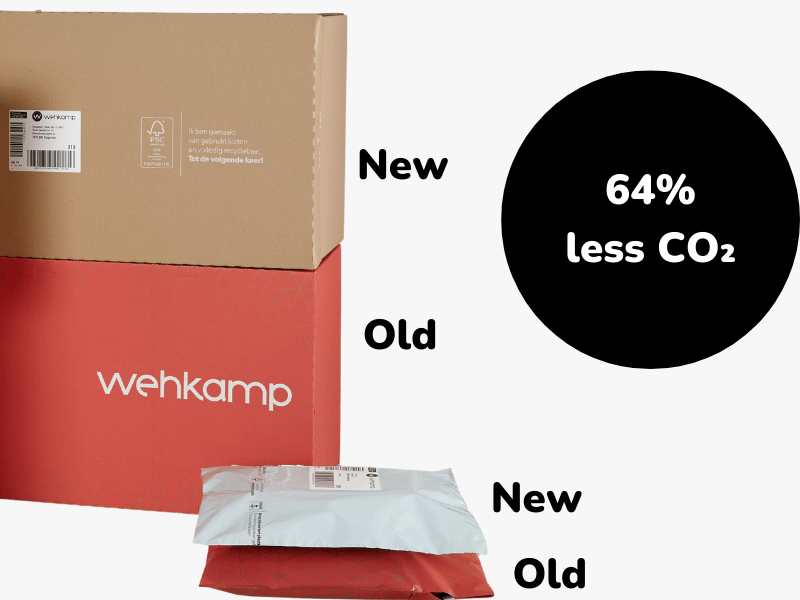
What is the ecological footprint of plastic bags?
In the production of 1 kilogram of plastic shipping bags, between 1.7 and 3.5 kilograms of carbon dioxide are emitted. This is much more than cardboard. Of course, you can find different figures on the internet, but in the Netherlands, shipping is mostly done with polyethylene plastic.
💡 87% of consumers would rather not have their products shipped in plastic.
Unfortunately, the world still revolves much more around money than the environment. We are therefore fortunate that plastic is more expensive to produce than cardboard. This explains to a large extent why relatively few items are shipped in plastic. Only when necessary is plastic used, especially for food and clothing.
Why is food shipped in plastic?
Plastic packaging may have a poor environmental image, but it does make sense in preventing spoilage and damage to food. The environmental impact of food loss is actually greater than that of packaging.
Odd, but true: plastic packaging is usually better for the environment and climate than glass. This contradicts our intuition because glass is more natural than plastic. Per kilogram, glass is also more sustainable than plastic, but we need many more grams of glass to package the same amount. If we require less than 1/6th in weight of plastic, it is the better choice for the climate than glass.
Why is a lot of clothing shipped in plastic?

Polybags are typically made of polythene or polypropylene. These materials require crude oil and are not biodegradable. Yet, many clothing stores use them because they protect the clothing from damage and moisture during shipping.
Without the plastic, there is a risk that a whole batch of clothing becomes unsellable. The loss of the environmental impact and the labor required to make that clothing does not outweigh the environmental damage of plastic.
Clothing itself already has a significant environmental impact; 10% of global emissions are related to fashion. From growing all the fibres, making and dyeing the fabrics, cutting and sewing the clothing, and transportation. Plastic ensures that clothing storage spaces do not need to be optimally heated and kept free of moisture.

Recycled Plastic
More and more plastic shipping bags are being made from (partially) recycled plastic. Along with other environmental organizations, kuwi.org is committed to achieving a 50% reduction in virgin plastic by 2030. This requires a paradigm shift. The major disadvantage of recycled material (for marketers and companies) is the dull look and feel because bright colors are only possible with new material. That’s why we, together with companies, are working to make this dull look and feel cool!
Unfortunately, there are still disadvantages to plastic. The process is (still) quite inefficient and requires a lot of energy. Recycled plastic is also of lower quality and can be recycled up to a maximum of five times. These are aspects that we may be able to address in the future, but one important aspect we can address now. 88% of plastic is not recycled, and this is largely due to the consumer. As a reader on kuwi.org, you probably have a green heart, and we hope our readers can encourage people in their surroundings to take that extra step.
Bioplastic
Bioplastics are plastic materials produced from renewable biomass sources such as vegetable fats and oils, cornstarch, straw, wood chips, sawdust, recycled food waste, and more. So far, they have been primarily derived from cornstarch, but the technology is fully under development and very promising.

Even in 2023, Bioplastics are still not widely used, and this is not only due to high costs but also because the entire process still has a significant ecological footprint. Efforts are underway to reduce this footprint, which is crucial because the primary advantage of bioplastics is their independence from fossil fuels as a raw material, as these resources are finite.


